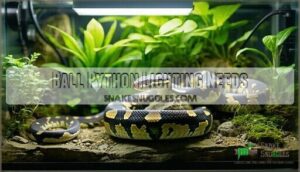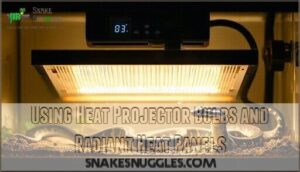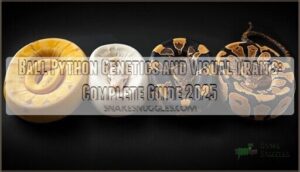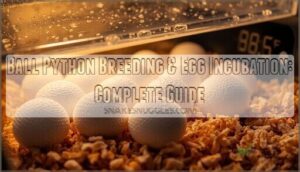This site is supported by our readers. We may earn a commission, at no cost to you, if you purchase through links.
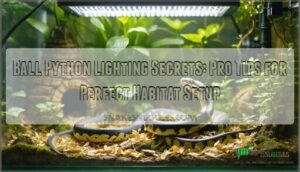
You’ll want to focus on providing a gentle UVB light that mimics natural sunlight, helping your snake’s metabolism and vitamin D production.
Choose a low-wattage UVB bulb that covers about 10-12% of your enclosure, positioning it to create a warm basking spot around 88-92°F.
Don’t overdo it – ball pythons don’t need intense lighting, just a subtle day-night cycle.
Pair your UVB with a ceramic heat emitter to maintain consistent temperatures, and you’ll create a comfortable habitat that keeps your scaly friend happy and healthy, with a proper metabolism.
Table Of Contents
- Key Takeaways
- Ball Python Lighting Needs
- Choosing Right Light Spectrum
- Temperature and Humidity Levels
- Setting Up Lighting and Heating
- Maintaining Optimal Environment
- Frequently Asked Questions (FAQs)
- What is the best light setup for a ball python?
- What is the light schedule for a ball python?
- What wattage for a 40 gallon ball python?
- Can ball pythons live without UVB lighting?
- How often should UVB bulbs be replaced?
- Do ball pythons need nighttime lighting?
- What happens if humidity is too low?
- Can I use LED lights exclusively?
- Conclusion
Key Takeaways
- You’ll need a 6-12% UVB bulb from reliable brands like Arcadia or ZooMed that’s replaced every 6-12 months to ensure proper light spectrum and vitamin D3 synthesis for your ball python’s health.
- Set up a precise temperature gradient with a basking surface of 95-104°F, using a reliable thermostat and heat sources like halogen bulbs to mimic the snake’s natural habitat and support optimal thermoregulation.
- Maintain a consistent 12-hour day-night cycle with full-spectrum lighting, which helps regulate your ball python’s circadian rhythm, supports melatonin production, and promotes mental well-being.
- Keep humidity levels between 60-80%, with spikes up to 100% during nighttime, using digital hygrometers and strategic misting to support proper shedding and prevent respiratory issues in your snake’s environment.
Ball Python Lighting Needs
If you want your ball python to thrive, you’ll need to master the art of lighting in their habitat.
Understanding the right UVB and full-spectrum lighting techniques can make the difference between a healthy, vibrant snake and one that’s just surviving.
Importance of UVB Lighting
The humble UVB light isn’t just a fixture—it’s a lifeline for your ball python’s D3 synthesis and mental wellbeing.
While not strictly essential for survival, proper reptile lighting can dramatically improve your snake’s natural behavior.
Strategically placed bulbs mimicking their native light spectrum offer more than illumination; they’re a gateway to your python’s peak health.
Many keepers utilize low wattage bulbs to provide adequate light without overheating, which is crucial for maintaining a comfortable environment for your ball python, supporting its overall mental wellbeing and ensuring the right conditions for D3 synthesis.
Benefits of Full-Spectrum Lighting
After exploring UVB lighting basics, let’s illuminate the sphere of full-spectrum lighting for your ball python’s habitat.
Here’s why it’s a game-changer:
- Supports plant growth in bioactive setups
- Enhances natural color vibrancy
- Provides mental stimulation
- Mimics natural light conditions
- Promotes circadian rhythm regulation
These lights aren’t just about brightness—they’re about creating a vibrant, life-like environment that keeps your scaly friend thriving and engaged.
Avoiding Inefficient Lighting Options
When setting up your ball python’s habitat, steer clear of lighting pitfalls that can harm your scaly friend.
Certain lighting choices can spell trouble for your reptile’s health and happiness.
| Lighting Type | Risk Level | Recommendation |
|---|---|---|
| Coil UVB | High | Avoid completely |
| Red Light | Moderate | Never use |
| Incorrect Wattage | High | Match to enclosure |
| Blocked UVB | Critical | Verify direct exposure |
Choosing Right Light Spectrum
When setting up your ball python’s habitat, choosing the right light spectrum isn’t just about brightness—it’s about creating a comfortable environment.
I’ll create a blockquote that captures the essence of the paragraph’s message about ball python lighting:
Illuminate your snake’s world: Light is the brushstroke that paints a perfect reptilian habitat.
You’ll want to carefully select UVB and full-spectrum lighting that mimics your snake’s natural conditions.
This lighting is crucial for providing essential vitamin D3 synthesis and maintaining proper day-night cycles.
Calculating Wattage Based on Enclosure Size
One might wonder how to nail the perfect wattage for a ball python’s habitat. Calculating the right lighting involves more than guesswork.
- Enclosure dimensions directly impact heat distribution
- Size determines wattage requirements
- Distance between bulb and basking spot matters
Measure your PVC cage carefully and experiment with different heat sources to create a balanced temperature gradient that mimics your snake’s natural environment. You can use a ball python enclosure to help plan. Get it right, and you’ll have a happy, healthy pet.
Considering Temperature and Humidity Requirements
After calculating wattage, you’ll want to nail your thermal gradient and humidity control.
Your ball python needs a warm basking area around 95-104°F, with cooler zones dropping to 72-80°F.
Keep humidity between 60-80%, using a digital hygrometer to track levels.
A good thermostat helps maintain these precise conditions, preventing stress and keeping your scaly friend comfortable.
Selecting Suitable UVB Bulbs
Every ball python enthusiast knows that choosing the right UVB bulb can make or break your reptile’s habitat.
Here’s your reptile lighting guide for perfect UVB spectrum selection:
- Pick T5 HO linear fluorescent UVB bulbs from Arcadia or ZooMed
- Aim for 6000-7000K color temperature for ideal mental health
- Replace bulbs every 6-12 months to maintain effective UVB radiation
Proper UVB is essential and you can buy python UVB online. Your snake will thank you for this illuminating investment.
Temperature and Humidity Levels
You’ll want to nail down precise temperature and humidity levels to keep your ball python thriving in captivity.
Creating the right thermal gradient and moisture balance mimics their natural habitat, ensuring your scaly friend stays healthy and comfortable, with the right balance being crucial for their well-being, particularly in terms of humidity levels.
Ideal Basking Surface Temperature
Your ball python’s basking surface temperature is essential for its health.
Aim for a toasty 95-104°F (35-40°C) range, which mimics their natural habitat.
Use an infrared temp gun to precisely measure the surface temperature, ensuring your snake can warm up effectively.
Reliable heat sources like halogen bulbs help maintain this critical temperature zone for ideal thermoregulation.
Consistent monitoring helps avoid low temperature consequences.
Maintaining Thermal Gradient
The thermal gradient’s symphony orchestrates your ball python’s health and comfort.
Here’s why it matters:
- Creates essential temperature zones
- Mimics natural habitat conditions
- Supports metabolic regulation
- Prevents stress and health complications
Your snake needs a warm basking location and a cool zone, allowing natural thermoregulation.
Strategic heat sources and a reliable thermostat transform your enclosure into a perfect thermal landscape for your scaly companion, ensuring optimal comfort.
Humidity Range and Spiking
As night falls, your ball python’s humidity needs a boost.
Aim for a 60-80% range, spiking to 100% after dark.
This essential spike aids shedding, supports respiratory health, and mimics their natural habitat.
Use a digital hygrometer to monitor levels, and try misting or a moisture-retentive substrate to maintain ideal humidity conditions.
Setting Up Lighting and Heating
You’ll want to get your ball python’s lighting and heating just right to create a habitat that mimics their natural environment.
By carefully selecting the right UVB bulbs, heat projector panels, and maintaining proper temperature gradients, you’ll set up a comfortable and healthy home for your scaly friend.
Using Heat Projector Bulbs and Radiant Heat Panels
After maintaining steady humidity levels, you’ll want to focus on heating.
Heat projector bulbs and radiant heat panels are your go-to reptile heat sources.
Position deep heat projectors carefully to create a warm basking spot, and mount radiant heat panels strategically for overhead warmth.
Consider different bulb options for ideal heating.
Use a thermostat to control wattage and prevent overheating, ensuring your ball python’s comfort and safety.
Installing Belly Heat and Heat Mats
For ideal belly heat, select a reptile-specific heat mat that’ll keep your ball python cozy and safe. Strategic installation is key to preventing potential burns and ensuring proper warmth.
Looking for the right product? You can find reptile supplies online.
- Match mat wattage to your enclosure size
- Use a reliable reptile thermostat for temperature control
- Position the heat mat to create a gentle warming zone
Regulate carefully to maintain the perfect temperature gradient.
Customizing PVC Cages for Heating
When setting up your ball python’s home, you’ll want to customize your PVC cage with care.
Choose radiant heat panels or deep heat projectors that integrate seamlessly with the enclosure’s design.
Verify proper thermostat placement for emergency shutoff and temperature control.
Pay attention to ventilation and insulation to create a safe, comfortable habitat that mimics your snake’s natural environment.
Maintaining Optimal Environment
You’ll need to master the art of monitoring your ball python’s habitat conditions to guarantee their health and happiness.
By carefully tracking temperature, humidity, and lighting, you’ll create a thriving environment that mimics their natural habitat and keeps your scaly friend feeling comfortable and secure.
Monitoring Temperature and Humidity
Your digital hygrometers and infrared thermometers are your secret weapons in ball python habitat management.
Track temperature gradient zones painstakingly, using digital probe thermometers to monitor warm and cool sides. A proper temperature gradient is essential for the snake’s well-being.
Leverage misting techniques for substrate moisture, watching for humidity spikes that keep your snake comfortable. Quick, precise measurements guarantee your python’s environment remains consistently perfect.
Your python’s environment is crucial for its health, and with the right tools, you can ensure it stays healthy.
Adjusting Lighting and Heating as Needed
Because your ball python’s comfort is key, you’ll need to stay on top of lighting and heating adjustments throughout the year.
Here’s how to fine-tune your reptile’s habitat:
- Watch for seasonal temperature shifts
- Calibrate thermostats monthly
- Measure basking distance regularly
- Track humidity fluctuations carefully
Subtle changes can make a big difference in your snake’s health and happiness, so remain vigilant and responsive to your pet’s environment.
Creating Natural Day-Night Cycle
Consistently, replicating your ball python’s natural day-night cycle is essential for its well-being.
Mimic dawn and dusk by providing 12 hours of light and 12 hours of darkness, which supports melatonin production and maintains their circadian rhythm.
LED lighting can help simulate seasonal variations, ensuring your snake’s physiological and psychological health stays on track.
Frequently Asked Questions (FAQs)
What is the best light setup for a ball python?
You’ll want a 6-12% UVB bulb placed 8-22 inches above the enclosure, paired with full-spectrum LED lights on a 12-hour cycle. Choose Arcadia or ZooMed brands for reliable, snake-friendly illumination.
What is the light schedule for a ball python?
Light as a secret agent, your python needs a strict 12-hour day/night routine.
Mimic their natural habitat by switching lights on and off consistently, promoting healthy behavior and reducing stress in your scaly companion, with healthy behavior being a key aspect of their care.
What wattage for a 40 gallon ball python?
You’ll need a 50-75W halogen bulb for your 40-gallon ball python enclosure.
Position it to create a 88-92°F basking spot on one side, ensuring a proper temperature gradient for your snake’s comfort and health.
Can ball pythons live without UVB lighting?
You’ll survive without UVB, but your python won’t thrive.
While they can technically live, UVB lighting supports essential vitamin D3 synthesis, bone health, and mental well-being, making it more than just a luxury for your scaly friend.
How often should UVB bulbs be replaced?
You’ll want to replace your UVB bulbs every 6-12 months.
Their effectiveness diminishes over time, even if they still appear to be working.
Regular replacement guarantees your ball python receives the best ultraviolet radiation for health.
Do ball pythons need nighttime lighting?
You won’t use nighttime lighting for ball pythons.
They’re crepuscular reptiles that naturally experience darkness.
Black, blue, or red lights can disrupt their sleep cycle and cause mental stress, so keep their habitat dark during nighttime hours.
What happens if humidity is too low?
When your ball python’s humidity drops below 60%, it’ll struggle to shed properly, potentially causing skin damage, respiratory issues, and stress.
You’ll want to mist the enclosure and monitor humidity levels carefully.
Can I use LED lights exclusively?
LED lights alone won’t cut it for your snake’s habitat.
You’ll want to incorporate specialized UVB and full-spectrum lighting to support your ball python’s health, vitamin synthesis, and natural day-night rhythms effectively, ensuring effective support for your pet’s overall well-being.
Conclusion
Illuminating your ball python’s world isn’t just about lights—it’s about creating a slice of their natural habitat.
Your ball python lighting setup guide is your roadmap to reptilian comfort.
By carefully selecting UVB bulbs, managing temperature gradients, and mimicking natural day-night cycles, you’ll transform an ordinary enclosure into a thriving snake sanctuary.
Remember, patience and attention to detail are your best tools in crafting the perfect environment for your scaly companion.

